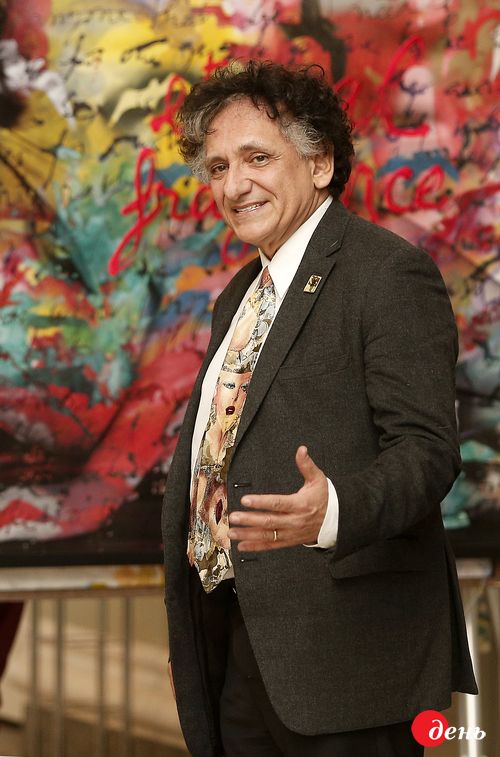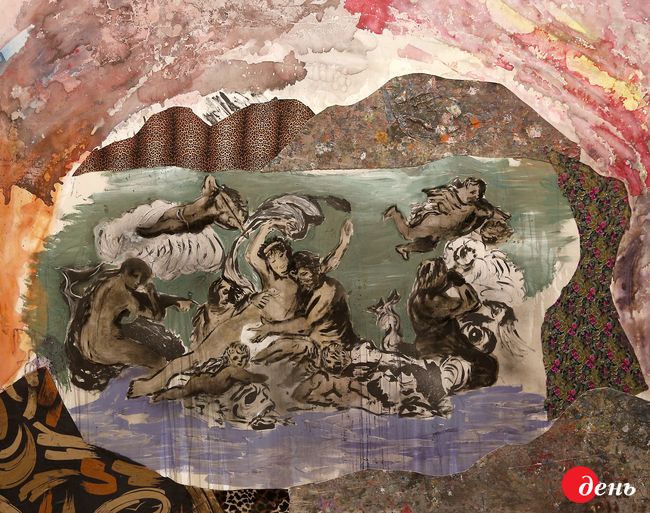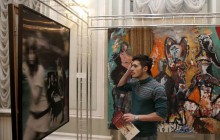I personally met the artist and saw not only a dozen of huge pictures he has painted in the past few years, but also about 20 books written by and about him. Besides, I had an opportunity to informally communicate with this handsome and elegant gentleman and his journalist wife Sibel.
PAINTING, CINEMA, THEATER, AND MANAGEMENT
The life of this uncommon artist is worthy of an optimistic adventure novel. The upbringing and work of Bedri Baykam show the way of a free individual active in many arts.
The boy was lucky that his talent was not only noticed by his parents, but also brought to the attention of the surrounding world. Bedri was only six when his first solo exhibit was held in his native city of Ankara. The first critical article appeared in a Turkish newspaper in 1963 and the next ones in the newspapers and magazines of other countries. His exhibit traveled across Europe (Bern, Geneva, Paris, Rome) and reached America. The Paris newspaper Le Figaro called him “the Mozart of painting,” and The Washington Post also paid attention to the exhibit of a talented child. The unhealthy ballyhoo about cashing in on the young genius’ works caused his parents to refuse to sell their son’s pictures.
In his teens, Baykam showed enthusiasm for cinema, theater, acting, and the secrets of film industry and theater management. After the triumph of his solo exhibits in Europe and America, parents sent the talented boy to a school in Switzerland to acquire the much-needed discipline and learn the most useful European languages – so it is no wonder that the young Bedri went to Paris for studies in 1975. The parents’ wealth and his own talent allowed the young artist to enter the Sorbonne and obtain an MBA in management and theater and film production. Does this mean that the wonder child betrayed himself and graduated to be a middle-level executive? Was it the diktat of his parents or a sober choice of Bedri himself? But, whatever the reason, the aspiration to secure a stable future did not prevent the youth from receiving specialized artistic education. The young artist concurrently enters another educational institution, L’Actorat, also in Paris, to study drama. He worked hard here, as always. This time, he mostly drew street scenes, landscapes, and nudes on paper with charcoal or Chinese ink.

The time spent in France gave the youth broad experience, but he still felt a longing for visual and figurative arts. So, he decided to acquire systematized knowledge and skills and went to the US to enter the California College of Arts and Crafts in Oakland, where he studied painting and filmmaking.
The artist considerably expanded the range of his instruments – he switched from doing watercolors and drawings to printmaking, began to paint in oil and, in the course of years, transformed pastose painting into transparent and acrylic. Little by little, graffiti and spray paint on plywood is added, oil paint fades away and acrylic takes the lead, which makes it possible to work faster and more actively. The bold synthesis of techniques and instruments, which now forms the basis of Baykam’s work, was born right here, in the US.
“NEW EXPRESSIONISM” AND “THE BOX OF DEMOCRACY”
After 12 years of studying abroad and going places, Baykam came back to Turkey in 1987 and settled in Istanbul.
The artist has a multifaceted talent. He has written several scripts, a lot of articles and speeches, and even the action-packed novel The Bone published in Turkish in 2000 and in English in 2005. It is in his homeland that the artist seems to begin to realize himself at full capacity.
Baykam continues to do and exhibit his artworks. Besides, he is an active citizen who defends the right of man to free development and democracy. He is not only the leader of the New Expressionism artistic movement but also a member of the Ataturkist Thought Association, one of the founders of the International Association of Art’s Turkish National Committee, and leads the Patriotic Movement. In October 2003 Baykam ran for the presidency of the Republican People’s Party.
In 2006 Baykam formed the “Pyramid” center of contemporary art in Istanbul, where he organizes exhibits, publishes books and albums. “Pyramid” is one of the most active and independent centers of contemporary art in Turkey.

In 2011, during his visit to the city of Kars, Turkish Prime Minister Recep Erdogan described the “Statue of Humanism,” which symbolizes Armenian-Turkish reconciliation, as a “freak” and called for demolishing it. This call immediately began to be fulfilled. Baykam was the first to stand up for the monument, saying that an Armenian-Turkish dialog is extremely important to his people and the Kars monument was the only major symbol of it. On the contrary, Erdogan showed an openly hostile attitude to Armenia. During a protest rally organized by Baykam, the artist and his female assistant were stabbed and wounded. Nobody doubted that the attack was connected with the artist’s active citizenship. But even this turn of events did not stop Baykam in his artistic and sociopolitical activities.
At the International Istanbul Biennial 2017, held under the motto “A Good Neighbor,” which raised ticklish questions about the political situation and crisis in Turkey, Baykam showed his work called “The Box of Democracy.” It is in the shape of a telephone booth which the author says “is a square meter of freedom. There are... couples who have entered and have made love. [It’s a] free space where you can do what you want.” This object is positioned as “a piece of Turkish democracy.”
“A 10-YEAR SELECTION”
Now the uncommon artist brought a solo exhibit at the invitation of the Ukrainian National Academy of Arts. He called it simply: “Bedri Baykam: a 10-Year Selection.”
A huge silver-golden frame with writings, “The Hard Job of Living,” is installed in the middle of the hall. Looking through it, as if it were a viewfinder, you can focus on what opens up to you personally – the whole exposition or a certain picture, the spectators or the artist himself. Bedri has a series of such “hollow” frames. They are of various colors and textures – silver, golden, black, red… Newlyweds used to go through the red one at the Venice Biennale 2015, making wishes for a happy future. Each installation carries a message from the author and, at the same time, gives space to the thoughts and associations of every spectator who can concentrate on and take part in the game the author, every new situation, theme, and angle of view dictate.
After examining closely the exposition, I suddenly realized that I had spent a lot of time, fascinated, in the hall and my colleagues had also seen the pictures. I was pleased to hear exacting and fault-finding professionals make surprisingly well-wishing comments and find the works very interesting.
The pictures are sensual and gripping. The canvases are full of interesting stories and symbols which it is a delight to read. To keep the spectator interested, Baykam, as an experienced stage director, picks certain visual techniques from the artistic domain of the “magic lantern” and adds some elements of cinema language and theatrical mise-en-scenes, carefully forming the dramaturgy of each work. To implement such ideas, the artist easily combines traditional techniques and cutting-edge technologies.

He is one of the first, if not the first, to dare apply the lenticular effect to pictures. It will be recalled that lenticular printing is a technology in which lenticular lenses (a technology that is also used for 3D displays) are used to produce printed images with an illusion of depth. Mass-scale production of this kind of items was launched in the 1970s in Japan. It is the stereo imaging we know from cute childhood-time “wiggle pictures,” where, for example, a beauty in the foreground raises a glass of wine and gives you a wink and, viewed from a different angle, opens the eye and drinks the wine, or Santa Clause takes gifts out of his bag near the Christmas tree, etc.
Baykam is proud of his pictures with this kind of augmented reality, calling them 4D, and says it is a special Turkish magic or something like a magic carpet for everybody. For, depending on the angle of view, we can see different images. Add to this the illusion of a very deep multidimensional space. This literally causes us to get immersed in the depths of reflections and feelings.
Bedri Baykam is a perfectionist by nature – he actively evades doing what everybody else does and, moreover, does not like repeating himself. He rapturously accepts and modifies the global art heritage, looking for his own ways in its labyrinth. Besides, he can see clearly and shows that his own artistic history grows out of the global one.
The theme of harem, its place in the Ottoman Empire, in the imagination and interpretations of Europeans and himself, runs through all the exhibited works. He shows his own admiration of women in general and the woman as an archetype, a passionate desire to possess this beautiful feminine world, self-irony and subtle mockery of his own admirations and wishes and the stereotypes that have formed in the minds of generations.
You will find some familiar heroes of pictures and films in the exhibited canvases. In “The Kiss: Homage to Munch Series” (4D, 185x120, 2010), figures from Edvard Munch’s canvases, which have frozen in a passionate kiss, go into a perspective on different levels and planes. Each of them mirrors a fraction of the author’s life and the experience of spectators. In the picture “How to Explain History to a Live Snail and Dead Hare” (4D, 180х240, 2009), the cocktail of composition and sense consists of bright ingredients, such as fragments of a Renaissance-era religious composition with an enormous green snail and the notoriously maddened Mona Lisa, airplanes that soar like seagulls in the sky and a seagull that hovers like an airplane – and all this corresponds with the characters of early- 20th-century adverts and a horror film hero with a dead hare in hand.
Bedri Baykam’s pictures of the given decade vividly show the movement of trends in world art in general and the Turkish artist in particular – from neoexpressionism and postmodernism to the so-called metamodernism.
The exhibit “Bedri Baykam: a 10-Year Selection” will remain open until April 7.
Olesia Avramenko is an art critic







